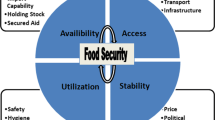Abstract
Modern agricultural revolution has enabled farmers to use Artificial Intelligence (AI)-based technologies resulting in improved crop yield, reduction in cost and optimization of the agricultural processes. Most of the food crops and grains are cultivated through farming and each food has its own characteristics, texture, color, shape, size, and granularity. Recognizing and identifying food items is necessary for calorie and nutrition estimation in order to maintain healthy eating habits and good health. Since the food items come in various textures, contents, and structure, it is tedious to distinguish food material. Texture is a prominent feature usually observed in all the agricultural food grains, and it is difficult to classify food material without recognizing its texture. It is evident that texture analysis and recognition is a significant and vital component in agriculture-based applications. The intention of the work is to prove the significance of the deep architecture InceptionResNetv2 model integrated with machine learning classifiers and to assess the performance of the classifiers in food classification system. We tested our proposed model with challenging RawFooT food texture dataset with 68 classes using10 fold cross validation. Extensive ablation study and analysis demonstrated an excellent accuracy of 100% with linear discriminant analysis and 99.8% with Quadratic SVM classifier for RawFooT dataset.
Access this chapter
Tax calculation will be finalised at checkout
Purchases are for personal use only
Similar content being viewed by others
References
Tyagi AC (2016) Towards a second green revolution. Irrig Drain 4(65):388–389
Matz SA (1962) Food texture. Avi Publishing Company
Koga T et al. (2003) Characterization and classification of foods by texture of food. J Jpn Soc Food Sci Technol
Chaugule A, Mali SN (2014) Evaluation of texture and shape features for classification of four paddy varieties. J Eng
Rosenthal A, Chen J (2015) Modifying food texture, volume 1: novel ingredients and processing techniques. Woodhead Publishing Series in Food Science, Technology and Nutrition. https://doi.org/10.1016/C2014-0-02669-X
Shen Z et al. (2020) Machine learning based approach on food recognition and nutrition estimation. Procedia Comput Sci 174:448–453
Liu C et al. (2017) A new deep learning-based food recognition system for dietary assessment on an edge computing service infrastructure. IEEE Trans Serv Comput 11(2):249–261
Patil NK, Malemath VS, Yadahalli RM (2011) Color and texture based identification and classification of food grains using different color models and haralick features. Int J Comput Sci Eng 3:3669–3680
Subhi MA, Ali SH, Mohammed MA (2019) Vision-based approaches for automatic food recognition and dietary assessment: a survey. IEEE Access 7:35370–35381
Nakamoto H, Nishikubo D, Okada S, Kobayashi F, Kojima F (2017) Food texture classification using magnetic sensor and principal component analysis. In: Proceedings of the 2016 3rd international conference on computing measurement control and sensor network, pp 114–117. https://doi.org/10.1109/CMCSN.2016.39
Pinto LS, Ray A, Reddy MU, Perumal P, Aishwarya P (2017) Crop disease classification using texture analysis. In: Proceedings of the 2016 IEEE international conference on recent trends in electronics, information and communication technology (RTEICT 2016), pp 825–828. https://doi.org/10.1109/RTEICT.2016.7807942
Cusano C, Napoletano P, Schettini R (2016) Evaluating color texture descriptors under large variations of controlled lighting conditions. J Opt Soc Am A 33:17
Szegedy C et al. (2017) Inception-v4, inception-resnet and the impact of residual connections on learning. In: Thirty-first AAAI conference on artificial intelligence
Kamilaris A, Prenafeta-Boldú FX (2018) Deep learning in agriculture: a survey. Comput Electron Agric 147:70–90
He K et al. (2016) Deep residual learning for image recognition. In: Proceedings of the IEEE conference on computer vision and pattern recognition
Fisher RA (1936) The use of multiple measurements in taxonomic problems. Ann Eugen 7(2):179–188
Kim KI et al. (2002) Support vector machines for texture classification. IEEE Trans Pattern Anal Mach Intell 24(11):1542–1550
Breiman L (2001) Random forests. Mach Learn 45:5–32
RawFooT DB: raw food texture database (2015). http://projects.ivl.disco.unimib.it/rawfoot/
McAllister P et al. (2018) Combining deep residual neural network features with supervised machine learning algorithms to classify diverse food image datasets. Comput Biol Med 95:217–233
Author information
Authors and Affiliations
Corresponding author
Editor information
Editors and Affiliations
Rights and permissions
Copyright information
© 2023 The Author(s), under exclusive license to Springer Nature Singapore Pte Ltd.
About this paper
Cite this paper
Simon, P., Uma, V. (2023). Integrating InceptionResNetv2 Model and Machine Learning Classifiers for Food Texture Classification. In: Kumar, A., Mozar, S., Haase, J. (eds) Advances in Cognitive Science and Communications. ICCCE 2023. Cognitive Science and Technology. Springer, Singapore. https://doi.org/10.1007/978-981-19-8086-2_51
Download citation
DOI: https://doi.org/10.1007/978-981-19-8086-2_51
Published:
Publisher Name: Springer, Singapore
Print ISBN: 978-981-19-8085-5
Online ISBN: 978-981-19-8086-2
eBook Packages: Computer ScienceComputer Science (R0)




